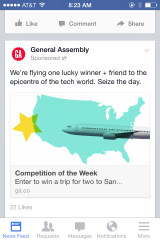 By Dave Link
By Dave Link
There has been an immense amount of discussion in the marketing and public relations industries surrounding “native advertising” during the past few months.
In case you’ve missed the deluge of posts, this new and groundbreaking type of advertisement is set to change the way we all market our products.
Or is it?
Native advertising is just well thought-out content with a focus on how users consume it on any given platform.
Robert Rose published an excellent feature on the topic earlier this fall.
Native Advertising is Just Good Advertising
When I say “good advertising,” I’m not talking about ads that have gone viral or that take advantage of the latest and greatest smartphone tech.
I’m talking about ads that fit almost seamlessly into the landscape of any given platform.
Ads that fit in so well users often won’t even recognize them as ads.
Isn’t this the type of marketing to which we all aspire?
This approach to native advertising is really born out of ad blindness. We’re all bombarded with so many ads day in and day out that we tune them out in favor of things that really matter to us: Photos, tweets from friends and mentors, and, according to YouTube, cat videos.
But, while we’re consuming the things that really matter to us, we’re also tuning out multiple banner ads that pop up alongside of our news feeds and news articles.
In all honesty, when was the last time you voluntary clicked on a banner or pop-up ad?
Enter Native Advertisement
To blast past the blindness, we now have the opportunity to publish our messages into the news feeds of platforms such as Facebook, Twitter, and Instagram.
All this ‘new’ form of marketing has done is present us with the opportunity to do what we should’ve done from the start: Publish ads that fit the medium and don’t stick out like a sore thumb. You wouldn’t publish an ad formatted for the web in a magazine, would you? So, why would anyone assume ads on Twitter shouldn’t be different than those on Facebook?
Maybe that’s why some companies and firms are having difficulty with native ads. The larger the organization, the more likely they’re relying heavily on scalable processes. While you can share the same story over numerous channels, this platform-centric approach to crafting a story can require a much more time intensive approach.
The Instagram Example
I can’t think of a more personal feed advertisers will try to break into than an Instagram user.
To get any sort of long term buy-in from users, Instagram ads will have to appear no different than that of any user’s post.
Warby Parker does an excellent job of mixing the art of Instagram photography with effective branding.
Take a look at the NASA Instagram feed for an example of how to blend with the everyday user.
Without Utility, it’s Just Another Ad
Who wouldn’t find the Curiosity’ s latest panoramic view of Mars captivating?
NASA takes it a step further, attaching an in-depth description to provide a history lesson in miniature.
Not only do they snag you with an interesting image, but they’ve taught you something that will likely have you seeking their posts in the future.
Location-based Native Advertising
Let’s look at another example, this time in Foursquare.
When using the app, the platform now presents hyper-relevant ads based on the type of venue you’ve checked into. While this is hardly a seamless integration, the utility of the ad often trumps its somewhat intrusive nature.
A perfect example: While checking in at my home, I’m presented with a Samsung ad reminding me not to forget my phone/wallet, and promoting the company’s new Galaxy Gear line. For gadget nuts like myself, that’s extremely effective.
It Has to Be Valuable
Ultimately, if you’re not putting together social ads with a purpose, or including engaging content to back them up, then it doesn’t matter if your ads are native, non-native or packed full of 100 Grumpy Cats.
If your ad isn’t useful and valuable – no matter what your user’s definition of value is – it’s not going to hold water.